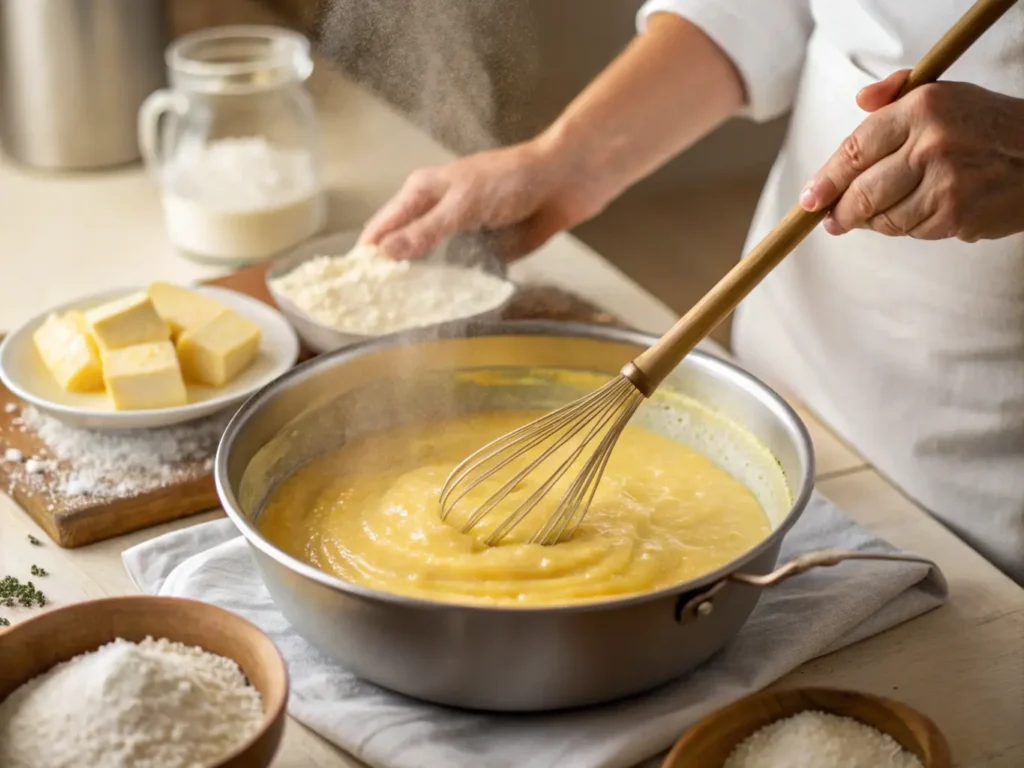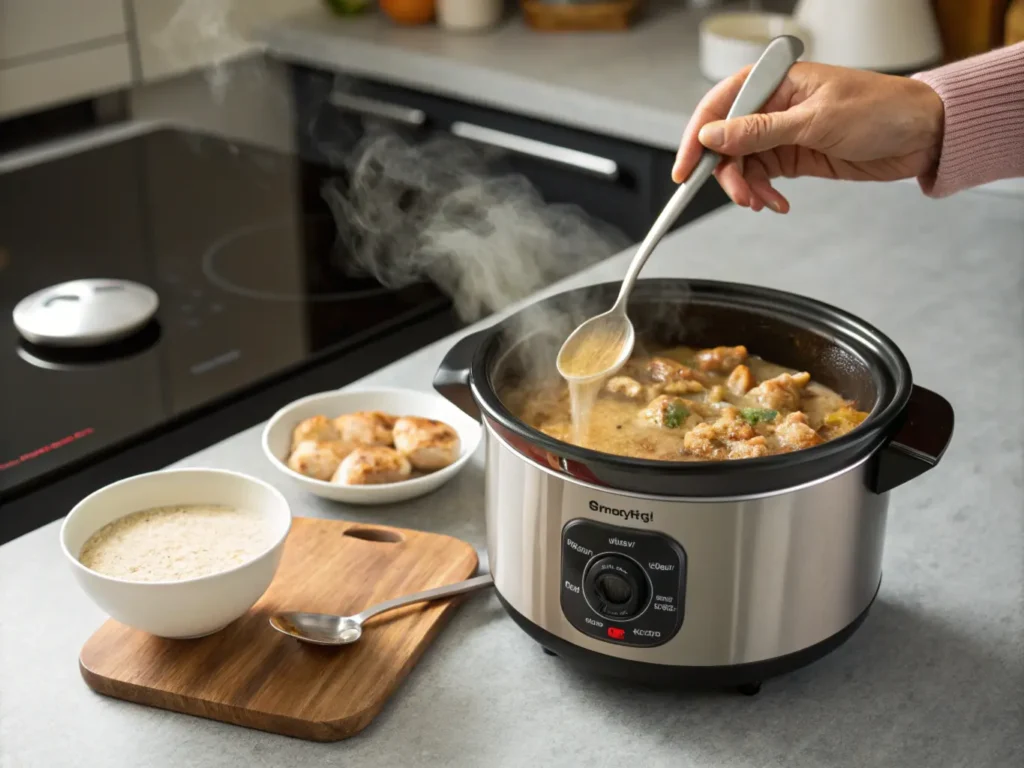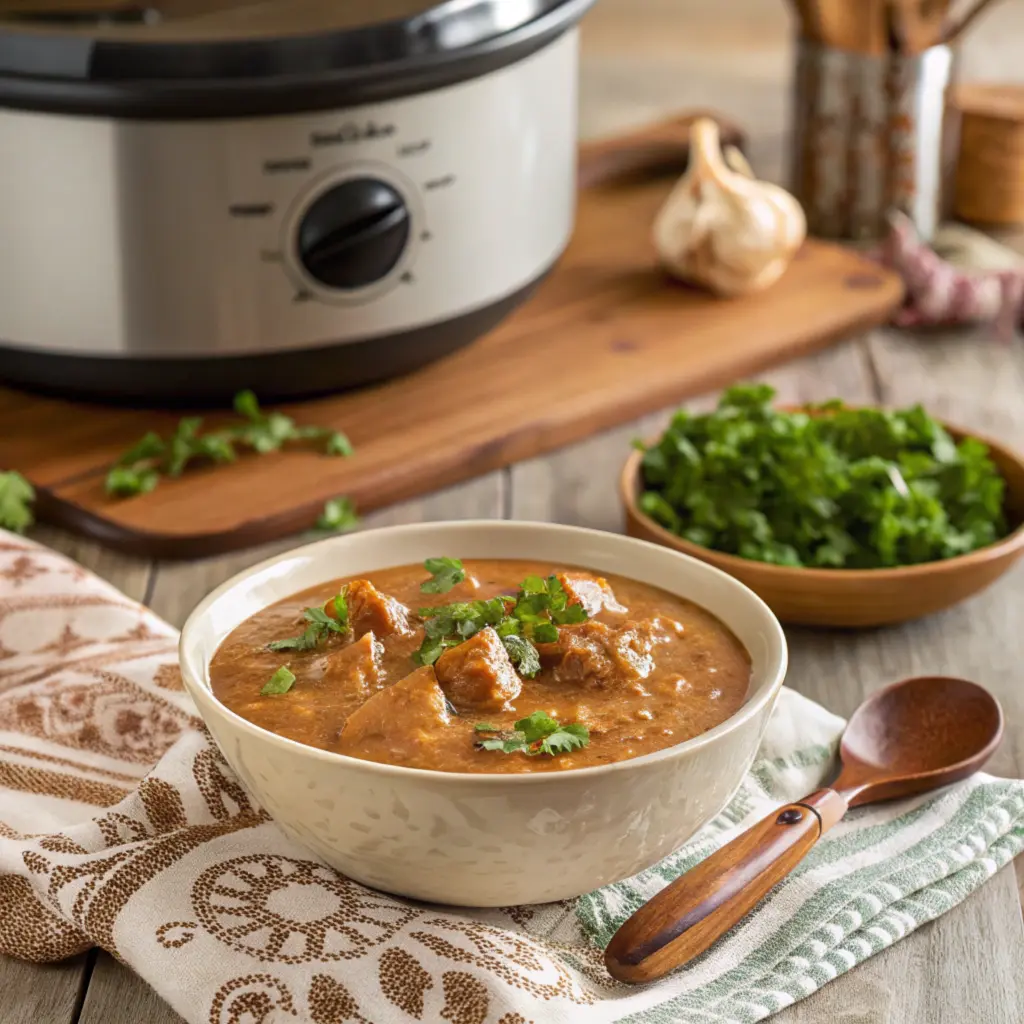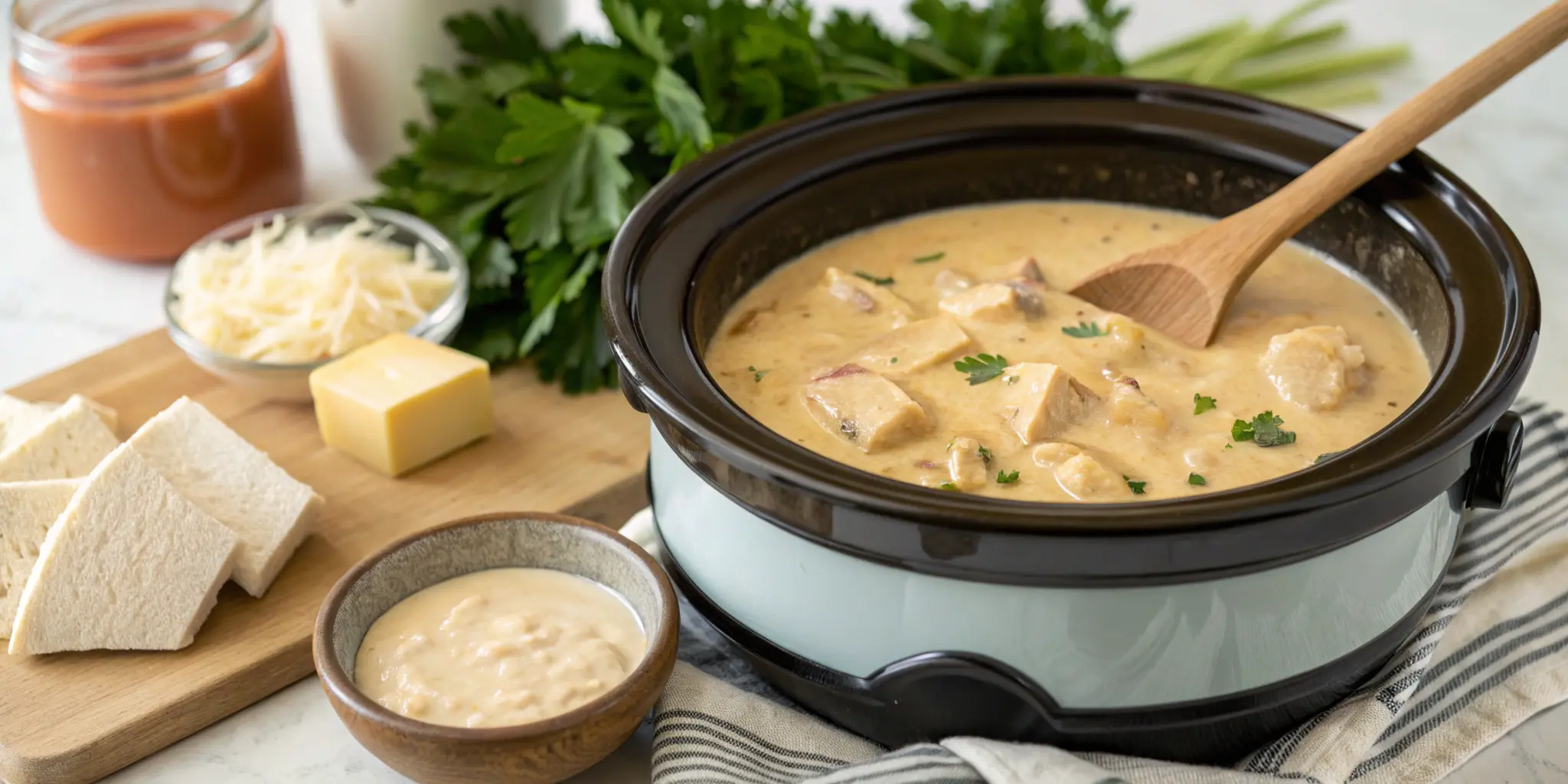Creating a perfect chicken gravy in a crockpot can be tricky, especially when it turns out thinner than expected. But don’t fret! With the right techniques and a bit of patience, you can achieve a rich, velvety consistency. This article provides step-by-step instructions, essential tips, and common-sense solutions to thicken chicken gravy in a crockpot. From using traditional methods like roux to modern alternatives such as cornstarch slurry, we’ve got all the bases covered.
If you’re looking for an easy-to-follow recipe that combines creamy chicken with luscious gravy, don’t miss this Ultimate Crockpot Chicken and Gravy Recipe. It’s the perfect dish to try once you’ve mastered the art of thickening gravy in a crockpot.
Understanding the Importance of Gravy Consistency
Why Gravy Thickness Matters in Culinary Dishes
Gravy isn’t just a sidekick; it’s the star that ties a meal together. Whether you’re serving roasted chicken or hearty mashed potatoes, a perfectly thickened gravy enhances the dish’s flavor and texture, creating a mouthwatering experience. Thin gravy, on the other hand, can feel more like flavored water, missing the mark entirely. A proper consistency ensures that every forkful is coated in rich, velvety goodness.
Thicker gravy also carries flavors better, allowing herbs, spices, and umami notes to shine through. It clings to your food, making each bite more satisfying. Plus, it’s visually appealing—nothing beats the sight of a luscious gravy cascading over a plate! Achieving the perfect texture elevates your dish from homemade to professional-grade without any unnecessary fuss.
Common Issues with Thin Gravy in Slow Cooking
Slow cookers, though wonderfully convenient, have a tendency to produce runny gravies. Why? They lock in moisture, and all that extra liquid can water down your sauce. Adding too much broth or skipping thickening agents are common culprits. Another issue? Timing. Thickening gravy too early in the process often leads to a texture that breaks down over time.
But don’t worry! With simple fixes and proper timing, these problems are easy to avoid, leaving you with a hearty, delectable gravy every time.
The Role of a Crockpot in Making Chicken Gravy
Benefits of Using a Slow Cooker for Gravy Preparation
A crockpot is a game-changer when it comes to preparing chicken gravy. It offers the luxury of slow, even cooking, allowing flavors to develop naturally over time. By simmering your ingredients gently, the crockpot enhances the depth and richness of the gravy without constant monitoring. This hands-off approach is perfect for busy cooks who want great results with minimal effort.
Another significant advantage is its ability to keep ingredients moist. While traditional stovetop methods can dry out chicken or lead to burned gravy, a crockpot ensures tender meat and prevents overcooking. Plus, the enclosed environment retains all the juices released by the chicken, which can be transformed into a flavorful base for your gravy.
Challenges Faced When Thickening Gravy in a Crockpot
Despite its benefits, the crockpot has its quirks. Its sealed lid traps steam, making it harder for excess liquid to evaporate, which often results in thinner gravies. Thickening agents like flour or cornstarch don’t behave the same way in a slow cooker as they do on a stovetop, requiring careful timing and proper mixing to avoid clumps.
Additionally, the longer cooking times can sometimes break down thickeners, leaving your gravy thin again by the end. However, by learning the right techniques, such as adding thickening agents at the right stage or adjusting heat settings, these challenges are easy to tackle.
Essential Ingredients for Chicken Gravy
Key Components for Flavorful and Thick Gravy
A stellar chicken gravy starts with a few core ingredients: chicken drippings, broth, and seasonings. The drippings capture all the flavors from your slow-cooked chicken, making them a must-have. Adding aromatic vegetables like onions, garlic, or celery builds complexity, while spices such as thyme or rosemary bring depth.
For thickening, all-purpose flour or cornstarch is the go-to, but alternatives like potato starch or arrowroot powder work well too. Cream or butter can be added for a rich, silky finish, and don’t underestimate the importance of salt and pepper to balance the taste. Every ingredient plays a role, so freshness and quality matter!
Importance of Proper Ingredient Ratios
When it comes to making gravy, the right ratios are crucial. Too much liquid dilutes the flavor, while too much thickener can leave the gravy gloopy and unappetizing. A good rule of thumb is to use about 1-2 tablespoons of thickening agent per cup of liquid. For added richness, include a small amount of fat—about 1 tablespoon of butter or cream per cup of broth.
Balance is key. Adjust ratios carefully, tasting as you go to ensure the gravy isn’t too salty, bland, or overly thick. With a little patience, you’ll master the art of crafting a perfectly balanced chicken gravy that complements every dish!
Utilizing a Roux for Thickening
What Is a Roux and How to Prepare It
A roux is a classic thickening agent made from equal parts fat (usually butter) and flour, cooked together to create a paste. It serves as the backbone for many sauces and gravies due to its ability to add both body and flavor. The cooking process removes the raw taste of the flour while the butter adds richness.
To prepare a roux, melt butter in a pan over medium heat, then gradually whisk in flour until the mixture is smooth and lump-free. Cook the roux, stirring constantly, until it reaches the desired color—light for a subtle thickener, or golden for a nuttier flavor. For gravy, a pale or golden roux works best as it thickens without overpowering the dish.
Incorporating Roux into Crockpot Gravy
Adding a roux to a crockpot requires a little finesse. Because the crockpot operates at lower temperatures than a stovetop, incorporating the roux at the right time is key. First, prepare the roux separately on the stove. Once cooked, whisk it into the hot liquid in your crockpot during the last 30 minutes of cooking. This prevents the roux from breaking down and ensures the gravy thickens evenly.
To avoid lumps, add the roux gradually while stirring. Let the crockpot continue to simmer uncovered, allowing the mixture to blend and thicken naturally. This method not only improves the texture but also infuses the gravy with the roux’s rich, buttery flavor.

Implementing a Cornstarch Slurry
Preparing and Using Cornstarch Slurry Effectively
Cornstarch slurry is a quick and convenient way to thicken gravy, especially in a crockpot. It’s made by mixing equal parts cornstarch and cold water until it forms a smooth liquid. Unlike a roux, cornstarch doesn’t require pre-cooking, making it a time-saving option.
To use the slurry, ensure your crockpot gravy is hot but not boiling. Slowly pour the slurry into the gravy while whisking or stirring continuously. This prevents clumping and allows the cornstarch to activate, thickening the liquid almost instantly. Aim for 1 tablespoon of cornstarch per cup of gravy for a moderate thickness.
Timing for Adding Slurry to Achieve Desired Thickness
Timing is everything when working with cornstarch. Adding it too early in the cooking process can lead to a broken, watery gravy as prolonged heat weakens its thickening properties. Instead, introduce the slurry in the last 15-20 minutes of cooking. This gives it just enough time to work its magic without overcooking.
Once added, leave the crockpot uncovered to allow steam to escape, further thickening the gravy. Keep in mind that cornstarch continues to thicken as it cools, so don’t overdo it. Adjust with a bit more liquid if the gravy becomes too thick. With this simple technique, you’ll have a smooth, glossy gravy that clings beautifully to your dishes.

Alternative Thickening Agents
Using Arrowroot, Potato Starch, and Other Substitutes
While roux and cornstarch are common choices, alternative thickening agents like arrowroot powder, potato starch, and tapioca flour are equally effective. Arrowroot powder is particularly popular for gluten-free cooking and produces a clear, glossy gravy. If you’re curious about the health benefits of arrowroot and other dietary thickeners, check out this resource from Healthline for more information.
Arrowroot powder is a plant-based thickener that’s gluten-free and ideal for those avoiding wheat products. It creates a clear, glossy gravy, making it perfect for showcasing the natural colors of your dish. Arrowroot works best when mixed with cold water to form a slurry before adding it to hot liquids. However, it can break down under high heat, so it’s better suited for gravies that aren’t simmered for long.
Potato starch is another gluten-free option, derived from potatoes, with excellent thickening power. Like cornstarch, it needs to be mixed with cold water before use and is activated at lower temperatures. It thickens quickly and gives your gravy a silky, smooth texture.
Tapioca flour works well in slow-cooked dishes because it holds up under prolonged heat. It can be whisked directly into the gravy or added as a slurry. Tapioca’s slightly sweet flavor makes it an excellent choice for balancing savory gravies.
Comparison of Thickening Agents for Crockpot Chicken Gravy
| Thickening Agent | How to Use | Benefits | Drawbacks |
|---|---|---|---|
| Arrowroot Powder | Mix with cold water to form a slurry, add at the end | Gluten-free, produces a clear gravy | Can turn slimy if overcooked |
| Potato Starch | Mix with cold water and stir into hot gravy | Thickens quickly, smooth texture | Can become overly dense |
| Tapioca Flour | Add as a slurry or directly into hot liquid | Holds up well under prolonged cooking | Slightly sweet taste may not suit all |
| Cornstarch | Combine with cold water, add to hot gravy | Easy to find, thickens fast | Can break down over long cooking |
| Roux (Flour & Butter) | Cook equal parts butter and flour, whisk into gravy | Adds rich flavor, creates smooth texture | Requires preparation on stovetop |
Pros and Cons of Various Thickening Methods
Each thickening agent brings its own strengths and challenges to the table. Choosing the right one often depends on your recipe, cooking method, and personal taste.
- Arrowroot Powder: Produces a clear, glossy finish and works well at low temperatures, but it can turn slimy if overcooked.
- Potato Starch: Thickens quickly and adds a creamy consistency, but it may become overly dense if too much is added.
- Tapioca Flour: Holds up well under prolonged cooking, but its sweet notes might not suit all dishes.
- Cornstarch: Easy to use and readily available but can break down under long cooking times, leading to a thinner gravy.
- Roux (Flour and Butter): Adds richness and depth but requires more preparation and may alter the gravy’s color.
Experimenting with these alternatives allows you to find the perfect balance for your gravy, ensuring it suits your dish and cooking style without compromise!
Adjusting Cooking Times and Temperatures
Impact of Heat Settings on Gravy Thickness
The heat setting you choose on your crockpot has a significant effect on the thickness of your chicken gravy. Cooking on low heat ensures gradual thickening and prevents the gravy from scorching, while high heat can speed up evaporation but may also lead to uneven textures or separation.
For optimal results, use low to medium heat when incorporating thickening agents like roux or cornstarch slurry. This allows them to blend seamlessly without clumping. When you need to reduce excess liquid to thicken the gravy naturally, switching to a higher setting during the last 30 minutes can help—but keep an eye on it to avoid overcooking.
When to Remove the Lid to Allow Reduction
A crockpot’s sealed design traps moisture, which is great for slow cooking but not ideal when trying to thicken liquids. Removing the lid during the final phase of cooking lets steam escape, concentrating the flavors and reducing the gravy.
Timing is crucial here. Removing the lid too early can dry out the chicken, while doing so too late might not leave enough time for the reduction process to work. Ideally, uncover the crockpot during the last 20-30 minutes of cooking to strike a balance between consistency and moisture retention. Stir occasionally to ensure the liquid reduces evenly.
Avoiding Common Mistakes When Learning How to Thicken Chicken Gravy in a Crockpot
Preventing Lumps While Learning How to Thicken Chicken Gravy in a Crockpot
One of the biggest frustrations when figuring out how to thicken chicken gravy in a crockpot is dealing with lumps. However, this common issue can be avoided with a few straightforward steps. Always mix your thickening agent—whether it’s flour, cornstarch, or arrowroot powder—with cold water or broth to form a smooth slurry before adding it to the crockpot. This method ensures even distribution and minimizes the risk of clumps forming when the thickener meets the hot liquid.
If you’re using a roux to solve the problem of how to thicken chicken gravy in a crockpot, whisk it thoroughly into the warm gravy. Stir regularly as the gravy simmers in the crockpot to prevent any thickening agents from settling at the bottom and forming lumps. If lumps still appear, don’t stress—a quick strain through a fine-mesh sieve will restore the gravy’s smooth texture.
Balancing Flavors While Perfecting How to Thicken Chicken Gravy in a Crockpot
Balancing flavor is a key step when learning how to thicken chicken gravy in a crockpot. Overusing thickening agents like flour or cornstarch can dilute the seasonings, leaving the gravy bland. To keep the flavors intact, taste the gravy throughout the thickening process and adjust the salt, pepper, and spices as needed.
If the flavor feels flat, try adding a splash of chicken broth for richness or a touch of acidity, like lemon juice or vinegar, to enhance brightness. Use these sparingly to avoid overpowering the natural chicken essence. By striking the perfect balance, you’ll master both the flavor and texture of your gravy.
With these tips, how to thicken chicken gravy in a crockpot becomes a straightforward process, resulting in smooth, flavorful gravy every time.
FAQs on Thickening Chicken Gravy in a Crockpot
Can I Use Flour Directly to Thicken My Gravy?
Yes, but it’s not the best method. Adding flour directly to your gravy can result in lumps and an uneven texture. To avoid this, mix the flour with cold water or broth first to create a slurry, then whisk it into the hot liquid. Alternatively, you can cook the flour with butter to make a roux before incorporating it into the crockpot. Both methods ensure the flour blends smoothly while cooking, resulting in a lump-free, thickened gravy.
How Can I Fix Overly Thick Gravy?
If your gravy has turned out too thick, don’t worry—it’s an easy fix. Simply stir in small amounts of warm broth, water, or milk, one tablespoon at a time, until the desired consistency is reached. Make sure the liquid is warm to avoid shocking the gravy, which can cause separation. Taste and adjust the seasoning afterward, as diluting the gravy might lessen its flavor.
How Long Can I Cook Chicken in the Crockpot?
Cooking times for chicken in a crockpot depend on the heat setting and the cut of chicken. On low heat, chicken usually takes 6–8 hours, while on high heat, it’s done in about 3–4 hours. Bone-in pieces might need slightly more time, while boneless cuts cook faster. Overcooking can result in dry, stringy chicken, so use a meat thermometer to ensure the internal temperature reaches 165°F (75°C). For a more detailed guide on cooking times and tips, don’t miss this resource: How Long Can I Cook Chicken in the Crockpot? A Complete Guide.
How to Keep Crockpot Chicken Moist?
Keeping chicken moist in a crockpot is all about retaining enough liquid and cooking on low heat. Add enough broth or sauce to cover the chicken partially, and avoid overcooking by sticking to the recommended time. You can also baste the chicken occasionally with the cooking juices or use skin-on pieces for extra moisture. For additional expert tips and techniques on keeping chicken tender and juicy in a crockpot, visit this helpful guide: How to Keep Crockpot Chicken Moist.
Is It Okay to Put Raw Chicken in a Slow Cooker?
Yes, it’s perfectly safe to put raw chicken in a slow cooker. The extended cooking time and steady heat kill bacteria, making it safe to eat. Just make sure to reach an internal temperature of 165°F (75°C) for food safety. If you want a detailed guide on food safety and expert tips for cooking raw chicken in a slow cooker, read this comprehensive article: Is It Okay to Put Raw Chicken in a Slow Cooker? Safety & Tips.
Should I Brown the Chicken Before Adding It to the Slow Cooker?
Browning chicken before placing it in the crockpot is optional but highly recommended. Searing the chicken adds flavor and helps lock in juices, enhancing the overall taste of your dish. If time allows, brown the chicken in a skillet with a bit of oil before transferring it to the slow cooker. This extra step can make a big difference in flavor and presentation!
Mastering the Art of Thickening Chicken Gravy in a Slow Cooker
Recap of Effective Crockpot Chicken Gravy Thickening Methods
How to thicken chicken gravy in a crockpot doesn’t have to be a guessing game. The process begins with thoughtful preparation and the right techniques. Building a flavorful gravy base is essential. Start with high-quality chicken drippings, carefully chosen seasonings, and the proper liquid-to-thickener ratios. Reliable methods like preparing a roux or creating a cornstarch slurry ensure smooth, lump-free gravy.
For those exploring alternatives, arrowroot powder, potato starch, or tapioca flour are excellent options. These substitutes cater to dietary preferences, such as gluten-free cooking, while still delivering the desired texture. Adjusting slow cooker settings is another important step. Use low heat for gradual thickening and high heat during the final stage to promote evaporation. Removing the crockpot lid toward the end of cooking allows steam to escape, further aiding the thickening process.
Stirring regularly not only helps prevent clumping but also ensures the ingredients blend harmoniously. By timing the addition of thickeners and tasting frequently to balance flavors, you’ll perfect your approach to making chicken gravy thicker in a crockpot.

Encouragement to Experiment With Crockpot Chicken Gravy Thickening Methods
Perfecting the art of how to thicken chicken gravy in a crockpot involves both technique and creativity. Don’t shy away from experimenting with methods to find the perfect balance for your gravy. You might combine classic techniques—like starting with a roux and finishing with a cornstarch slurry—or try enhancing flavors with fresh herbs or spices.
Cooking is as much about personal preference as it is about the process. If your first attempt doesn’t go as planned, consider it an opportunity to learn. Each try at thickening chicken gravy in a crockpot helps refine your skills and improve your confidence.
With patience and practice, you’ll consistently produce smooth, rich, and flavorful gravies that elevate every meal. So roll up your sleeves, experiment boldly, and savor the satisfaction of a perfectly thickened chicken gravy made in your trusty crockpot!

